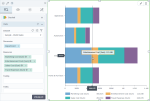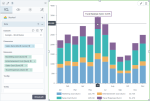Stacked bar (column) chart
|
|---|
Stacked bar chart |
|
|---|
Stacked column chart |
A stacked bar (column) chart compares two or more measures across one or two dimensions. This chart type displays bars or columns composed of segments. The segments represent the measures. Each measure is represented by a different color. The measures that you select need to show composition, therefore, they should be comparable and share the same scale and units of measurement.
In the bar charts, the measures are placed one after the other, from left to right. The width of each segment corresponds to its value. The right edge of each segment represents the cumulative total of that measure and all the measures preceding it.
In the column charts, the measures are placed on top of each other. The height of each segment corresponds to its value. The top edge of each segment represents the cumulative total of that measure and all the measures beneath it.
This chart type is best used to show part-to-whole relationships or to illustrate how a part-to-whole distribution changes over another dimension.
When to use
The stacked bar (column) chart can be used to illustrate the distribution of the following measures within a dimension:
- Sales and marketing costs, travel expenses, and entertainment costs – within the operating cost for each department.
- Building rent, insurance costs, subscriptions, and utilities – within the administrative expenses for each city.
- Operating and non-operating costs – within the total costs for each line of business and country.
The stacked charts are useful when the sum of the values is as important as the individual items.
A good rule is to use a maximum of three or four measures; otherwise, the chart can become hard to read.
A bar chart displays data as horizontal bars, while a column chart displays data as vertical bars. However, the data is processed the same way.
The following table shows the main differences between the two chart types.
| Use column charts to | Use bar charts to |
|---|---|
|
|
Data requirements
To build this chart, define the data fields as follows:
- Dimension – One or two dimensions
- Measure – Two or more measures
- Tooltip – (Optional) One or more measures
- Trellis – (Optional) One dimension
- Color – (Optional) One dimension
Use case
View the following use cases for the stacked chart, based on the chart orientation.
The following chart shows the composition of the operating cost per department. The operating cost is split into various cost types, represented by different colors.
This chart emphasizes the individual value of each cost type and the total value of the operating cost per department.
In this case, the bar chart is preferred to the column chart because the dimension is not related to time, and it has data with long labels.
The following chart shows the composition of the operating cost per month. The operating cost is split into entertainment cost, sales cost, and marketing cost, and travel cost. The cost types are represented by different colors.
This chart emphasizes the individual value of each cost type and the total value of the operating cost per month.
In this case, the column chart is preferred because time values are better understood when they are graphically represented from left to right.
References
For details on how to customize your visualization, see Visualization settings.
For a whole list of visualizations, see the following topics:
- Visualizations by function (find a visualization to suit your business case)
- Visualizations by type (find a visualization based on how it is organized on the interface)




Comments
0 comments